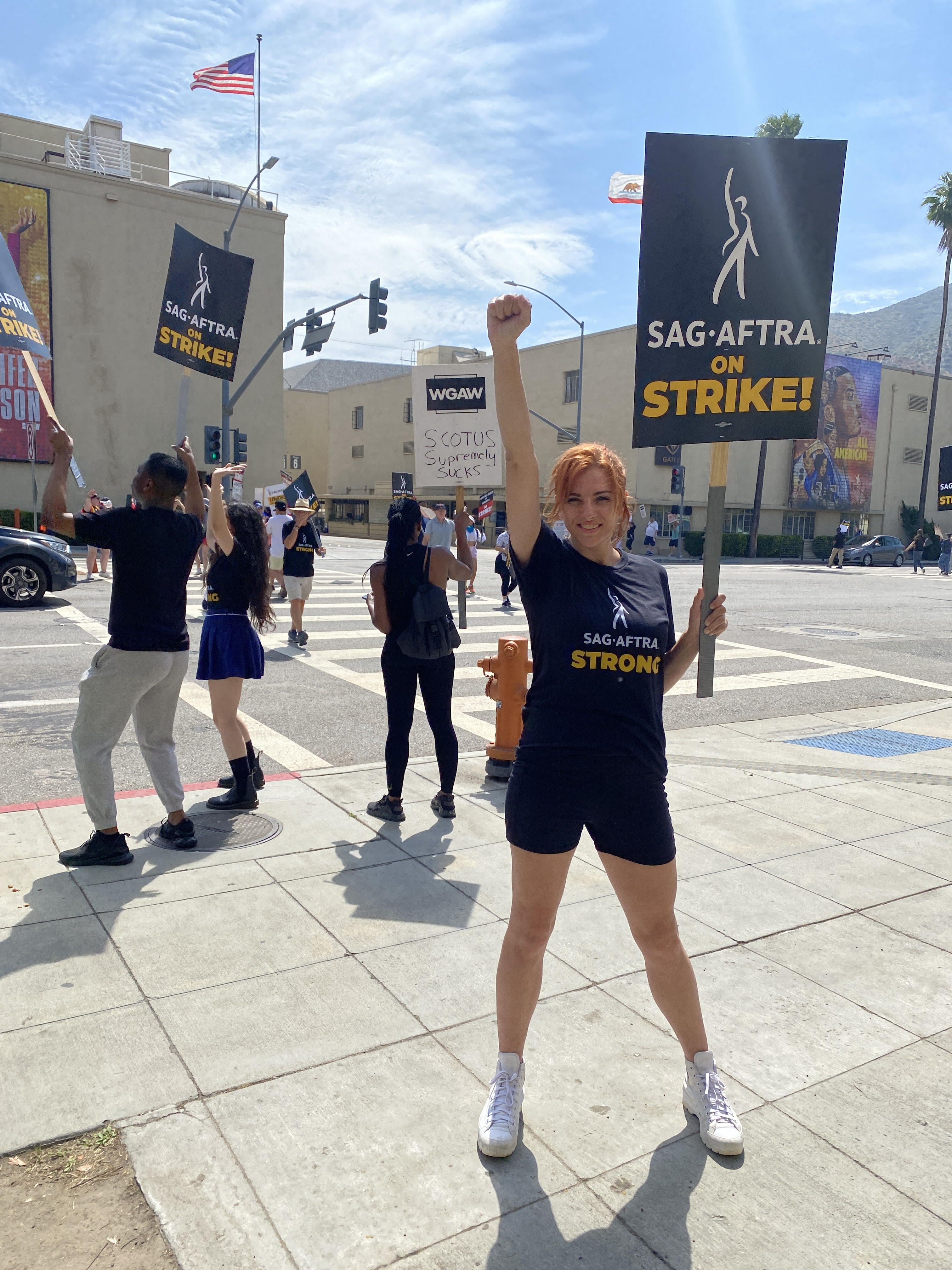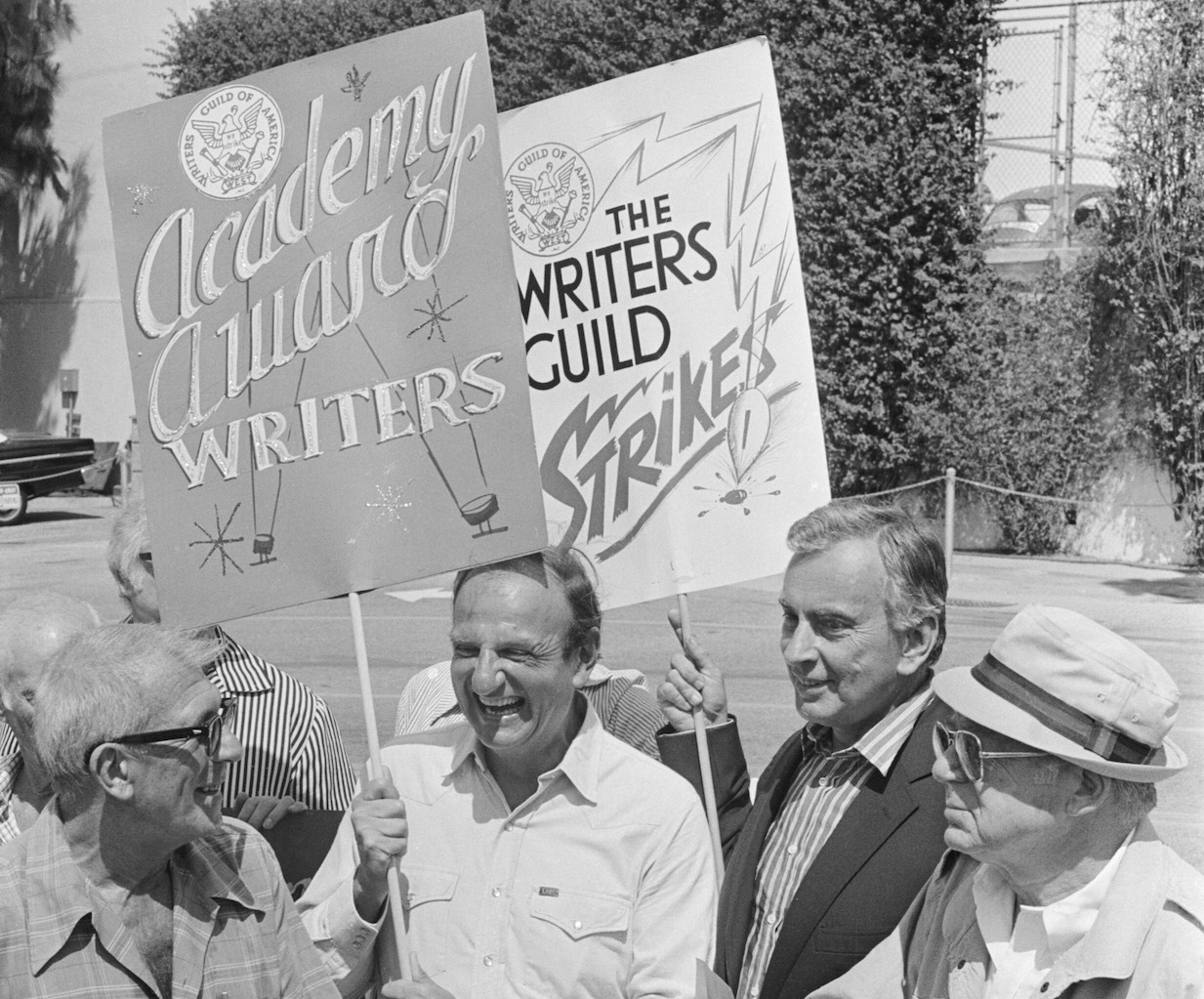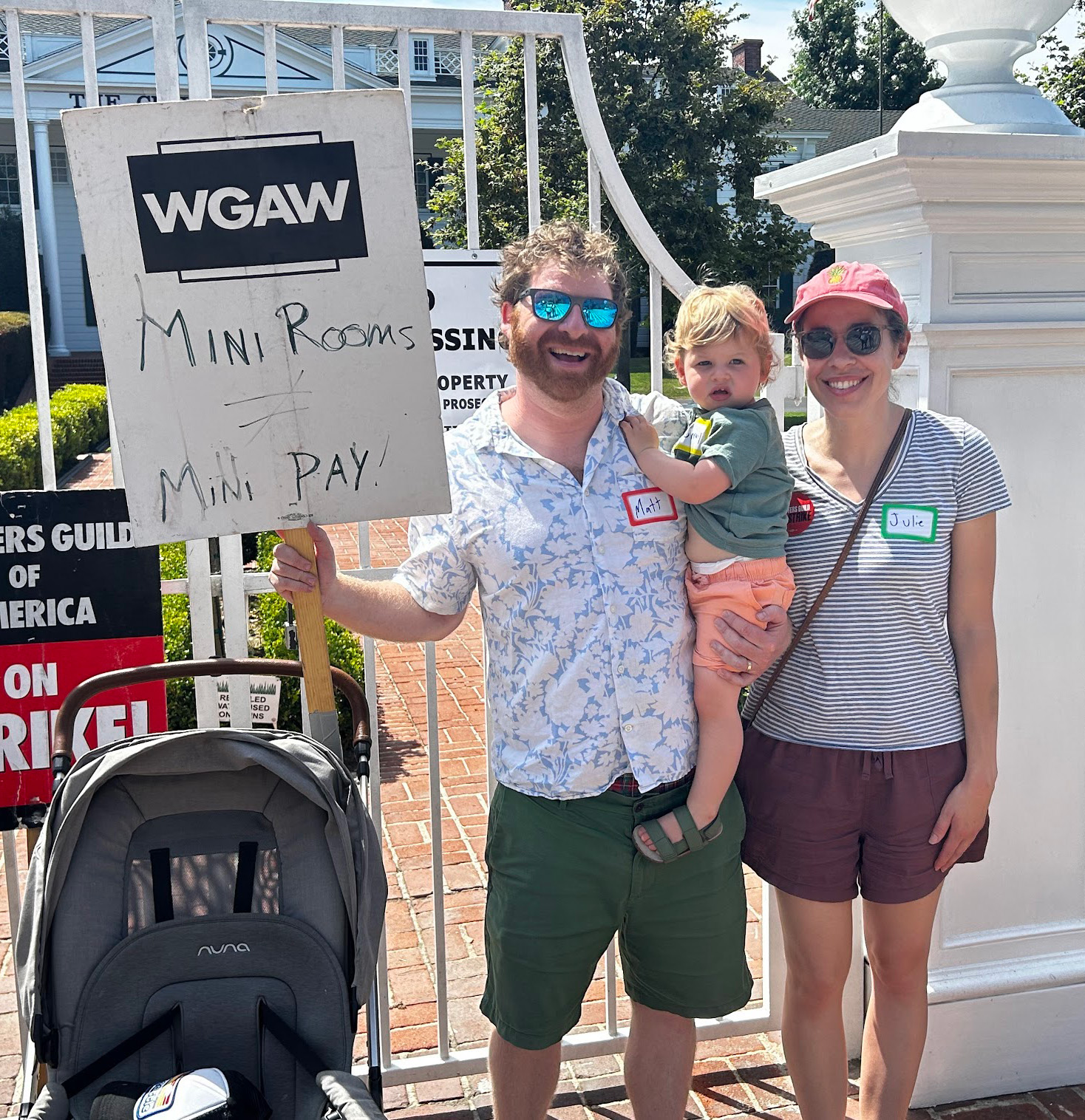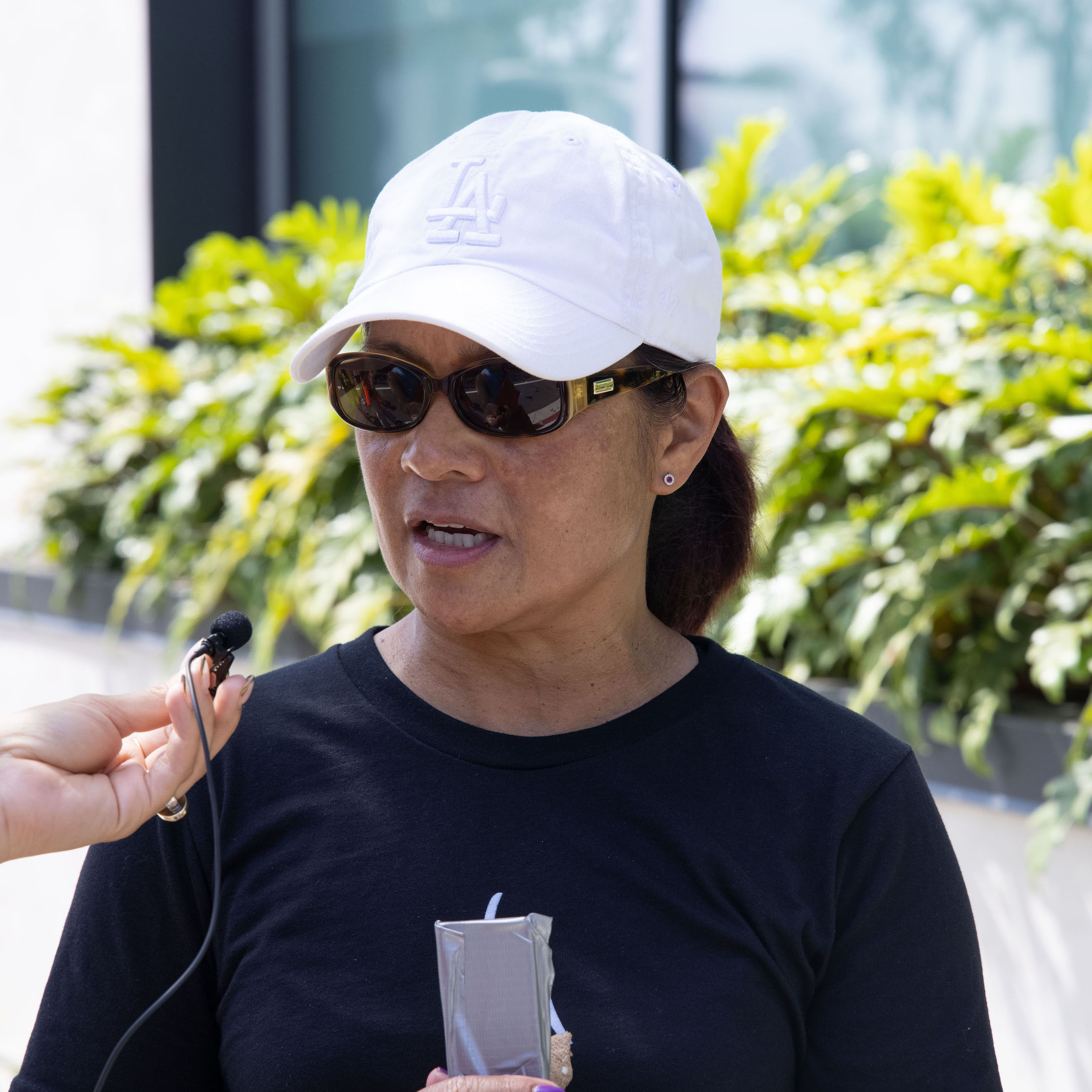Actors and writers are demanding major changes in the entertainment industry, including AI rules. What's in store for Hollywood creatives?
In the shadow of the towering Netflix headquarters in sunny Los Angeles, Breeda Wool stopped to pick up a wooden sign emblazoned with bold, red letters. A passing driver honked and her friends and fellow artists whooped and whistled in response. Blaring pop music mingled with shouting voices and barking dogs, but nothing could drown out the hundreds of feet pounding the pavement in solidarity. The organized chaos fed Wool’s spirit as she proudly waved her sign above her head –“SAG-AFTRA supports the WGA on STRIKE”
With her fiery personality and red hair to match, Wool arrived at the writer’s strike ready to champion union power. Marching shoulder-to-shoulder alongside angry, underpaid writers, she chanted slogans such as “Corporate greed has got to go! ”As an actor, she knew all too well the reality of production companies capitalizing on her hard work and talent. But her union wasn’t on strike – yet.
May slugged into June, then July. Tensions escalated between Wool’s union, SAG-AFTRA, and the Alliance of Motion Picture and Television Producers (AMPTP) as they struggled with contract negotiations. The long-anticipated strike announcement arrived on July 13. Once more, Wool stood outside the same iconic Netflix studio surrounded by the same deafening noises and excitement, but she felt hollow. She hoisted her sign, this time marked with the black and gold SAG-AFTRA logo, and began to walk the familiar picket line. Tears slowly leaked out of her hazel eyes and down her chin.Breeda Wool sits down with us at her manager’s home to discuss her career.


What’s At Stake?
Brianna Kellum and Kyle Louis, actors who describe themselves as being in the “supporting actor phase” of their careers, are pushing to achieve a middle-class income from acting. As a married couple of 16 years, they scoff at the question of wages – “for the strike to really impact us financially as actors, we’d have to be making a living from acting. Most actors we know are still ‘day players’ like us. Booking a job is a windfall, but we have to do other work to get by.” Herein lies the problem; actors already feel marginalized by what SAG-AFTRA President Fran Drescher called a “very greedy entity.”
For both the WGA and SAG-AFTRA strikes, the dispute is between the unions representing artists and AMPTP, the organization that negotiates on behalf of major studios like Disney, Amazon, Sony, Netflix, and Hulu.
Neither strike is solely about regulating artificial intelligence – central issues discuss changes to compensation structures and improvements to workplace safety and equality. However, for most actors and writers, contrary to pop culture's portrayal of Hollywood, building wealth (or even simply paying your bills) through their work has been improbable for many years.
AMPTP's reluctance to reach an agreement with the unions, thus leading to the strikes, is, as Louis describes, “like setting the house on fire to annoy the mice.” He says this with a chuckle, but the analogy is poignant. These actors and writers see their work devalued to the point that, to those looking down from above, they feel as small and dispensable as rodents. This feeling of dispensability fuels fears around AI.
Within both the WGA and SAG-AFTRA negotiations, proposals around AI became a rallying cry. A bulletin released by SAG-AFTRA detailing the negotiations, stated, “Performers need the protection of our images and performances to prevent replacement of human performances by artificial intelligence technology.” The fear of job replacement is real. For actors and writers alike, the threat of AI to the future of their industry is “existential.”

SAG + WGA strike together in 1960, petitioning for residual payments. View full timeline of the history of both unions here. Photo Source: Getty Images
AI’s Threat to Actors + Writers
Wool describes current AI technologies as a “regurgitative learning program that will get better over time.” While many pieces of AI-created content fall into the uncanny valley – the phenomenon where something looks too real to the point that it feels indescribable or creepy – when done well, the distinction between real and fake is blurry. Actors fear their image and likeness being scanned, replicated, and used without their consent. This is especially scary for background actors.
Background actors bring a scene to life through the addition of their human presence. They’re the 500 people lining the streets during Cersai Lanister’s Walk of Shame, the 1,000 passengers in the Titanic movie fighting for their lives in the water, and the people of Wakanda ready to go into battle. They’re anonymous, unnamed characters whose roles are essential to these iconic scenes. The nature of their position is to fall into the background, but their collective real presence is crucial to the believability of the cinema. That anonymity, however, makes them vulnerable, as they already struggle to support themselves at a day rate of $187.
According to a bulletin published by SAG-AFTRA, AMPTP believes they should have the ability to scan background actors’ faces and use their likeness in perpetuity. Studios could change the principal performer’s dialogue and create new scenes altogether without consent. AMPTP disputed this claim, calling it “false,” stating in a news release that they provided “groundbreaking AI proposals that protects actors’ digital likeness.
Neither SAG-AFTRA or AMPTP returned numerous emails and phone calls seeking elaboration on sticking points in negotiations.

Click for bigger version
For actors further along in their careers, the threat to background actors is a shared concern. “First they come for the background actors, then they come for the stuntmen, then they come for the featured talent… co-stars… and so on. This is a threat to all of us,” says Kellum.
In the case of writers, the fear of replacement is centered on AI’s ability to quickly and cheaply write scripts in the style of existing or established writers. Before machines can take over the jobs of writers, however, the AI system must learn how to produce human-like content. Generative AI systems lack the capacity to create anything entirely new. Rather, they mimic patterns they see in human-made content.
We asked AI to make a short film about the strikes and the future of the entertainment industry. Here’s what we created:
For Kellum, who describes herself as a writer even though she isn’t a member of WGA, this already limits the artistic value and necessity of AI – “if AI needs to learn from already existing pieces of content, how can it write original stories? Will all new stories just be derivative?.” For Kellum, this conjures up images of a bleak, undiverse future of storytelling where all we have are “superhero movies and reboots.”
Since at least 2015, Hollywood studios fired up AI-powered tools, like Cinelytec and Stroyfit, to help make key decisions in the film-production process. These tools shape how projects are greenlit by scanning previous films and running analytics across financial data to determine a script’s revenue potential. A similar process determines who to cast. For Louis, the inherent bias these tools could wield is apparent; “Black people weren’t in leading roles in films that long ago.” Given AI tools lack data on films starring Black actors, they may be less inclined to recommend a script starring Black characters.
Hollywood has faced a diversity problem since its inception. Sidney Poitier was the first Black man to win Best Actor at the Oscars in 1964. Some 38 years later, Denzel Washington would be the second. Only 10 women writers in the history of the Oscars have won for Best Screenplay. Jordan Peele was the first Black male writer to win Best Screenplay for “Get Out” in 2018. Bong Joon Ho and co-writer Han Jin Won were the first Asians to win for “Parasite” in 2020. Hollywood is predominantly a white man’s industry, despite a recent push for increased diversity. According to UCLA’s Diversity Report in Film people of color account for only 22% of lead actors, 17% of directors and 12% of writers, while women account for 39% of lead actors, 15% of directors, and 27% of writers.
AI doesn’t know what it doesn’t know. If tools like these continue to be deciding factors in what stories are worth telling, the increase in diversity we’ve seen in recent years is at risk of being reversed. Original stories, like “Everything Everywhere All At Once,” which stars a predominantly Asian cast, and “Moonlight,” which is centered around the story of a gay Black man, may have never been made if AI determined their value. A potential solution: prevent these tools from advancing through limiting their ability to learn from copyrighted material, like existing scripts and books. If the tools are no longer accurate, their value to studios decreases.

Matt Klinman and his family strike outside the Amazon Studios in Culver City.
Matt Klinman, a member of both WGA and SAG-AFTRA, sees a potential for AI to be used as a justification to underpay writers. Passionate about his industry, Klinman is apprehensive about its future. At the Amazon Studios in Culver City, he held a WGA strike sign in one hand and his son, Murray, in the other, while his wife stood beside him with Murray's stroller. As a writer, Klinman is wary of studios using AI to produce “what they claim are original ideas.” Armed with these simplistic, uninspired stories that AI spits out, studios could task a writer with developing them for a small fee, yet retain the intellectual property rights. “This will erode the amount of profit that writers can participate in,” Klinman said looking at his wife who nodded sadly. They are adamant that writers require protection against such exploitative practices to ensure fair compensation and rights over their work. .
WGA’s proposal on AI includes: “Regulate use of artificial intelligence on MBA (minimum base agreement) covered projects: AI can’t write or rewrite literary material; can’t be used as source material; and MBA-covered material can’t be used to train AI.”
Regulating the use of copyrighted materials as training tools for AI and limiting AI’s ability to write literary material could slow the proliferation of these technologies. OpenAI, the company behind Chat-GPT, and META are already embroiled in a legal dispute after actress and comedian Sarah Silverman joined a class-action suit accusing the companies of copyright infringement. Silverman pursued the suit after discovering that the AI tool could accurately summarize her book The Bedwetter. The suit claimed her book was “copied and ingested” to train Chat-GPT to mimic her voice via illegally acquired datasets containing her work, commonly referred to as “shadow libraries.”
This suit could lay the groundwork for how AI-related copyright infringement is handled. For the common writer or actor, like Wool or Louis or Kellum who live, or are striving to live, a middle-class lifestyle, pursuing legal action against major studios is a David vs. Goliath matchup.
“This is why we have unions,” Louis says proudly. “The kinship between SAG and our sister union WGA is real, we’re all fighting for the same thing – longevity.”
The Voices of the Strike

Graham Elwood

Melissa Acosta

Timothy Olyphant Photo source:Variety

Michael Kaleda
The Implications of AI
For the strikes to end, both unions must come to an agreement with AMPTP. While consent, compensation and credit may assuage the unions, artists are skeptical about AI’s capability to make worthwhile content and what that means for the integrity of storytelling.

Co-owners of Paxeros, an independent film production company, Chelsea Bo and Sean Drummond at the 2023 American Society of Cinematography Awards.
It’s tempting to imagine a dystopian future film industry, but AI is already being used in a myriad of ways. Chelsea Bo and Sean Drummond, partners and co-owners of an independent production company, believe it all comes down to intention. “Ethos-driven creative” is at the heart of their work and is reflected in the name of their company Paxeros– Pax, representing peace, and Erso, representing love. They believe that when AI is used as a “cost-saving and time-saving measure” you’re always going to get subpar results because the story is no longer “most important,” says Bo, who is also a director and an actor herself. There’s an old principle in creative production that says, “You can’t create something that is fast, cheap, and good. One thing always has to give.” When speed and cost take precedence, the story, and thus, the consumer experience, suffers.
Even with the most sophisticated and expensive form of AI, the current technology still can’t replicate humans. Bo and Drummond point to “Indiana Jones and the Dial of Destiny,” which has a major sequence in the film made by AI technology. Harrison Ford was aged down to his 1980s self with the help of generative AI tools called FaceSwap. Bo described the use of AI as “pretty painful to watch.” Real-life Ford acted in all the scenes, but the final product didn’t feel entirely real. Indiana’s too perfect — lacking the weathered skin and laugh lines that make each human a unique person. “People go to see films to have an authentic, human experience. I don’t know if AI will be able to pull that off,” Bo asserts.
Wool shares this same human-centric image of the entertainment industry. According to Wool, this need for a human-driven experience is what pushes writers and actors to stand together in solidarity. It all starts with a story; if “AI can’t make something that feels human” an actor can’t successfully bring that character to life. She boils it down to mortality as “exactly what makes us human.” Until AI can experience death and the emotions that come with it – fear, sadness, love – she doubts it will be able to“eek out a good piece of art.”
Wool struggles to imagine a world where a viewer can get invested enough in AI-generated stories to "binge eight hours of television in a single night" or pay to go to a movie theater. Klinman is also skeptical of AI's capability to connect with viewers. He compares watching AI-generated stories to “staring at the gears of a machine for hours.”
A Return To Analog
It comes down to economics and what will drive demand. With a highly saturated film and TV market, an overwhelming amount of content already exists. When AI is used as a way to make entertainment faster and cheaper, the number of films and TV shows could go up, while the quality could go down. Even the most loyal bingers have a fixed amount of time and viewers only want to watch content they’ll enjoy. Artists are hopeful that human-made stories will continue to rise to the top.
Louis simplifies generative AI down to “really sophisticated CGI (computer generated imaging),” which is already out of vogue for many filmmakers and critics. In 2023 thus far, three of the top 10 grossing films – “Barbie,” “Avatar: Way of the Water,” and “Oppenheimer” – have been praised for their use of practical special effects. Barbie used 2D set pieces to depict Barbie and Ken traveling to the real world, Oppenheimer used practical miniatures to recreate a nuclear explosion and Avatar’s underwater scenes were shot practically in pools of water. All of these films heavily promoted these scenes, using “fully human-made” as a marketing tactic. Audiences want to marvel at the capacity of human creativity, as evident by each film’s performance at the box office.
Film historian Pamela Hutchinson, in conversation with The Guardian hints that the industry is at a tipping point. When it comes to CGI, “Now we know that can be done, and we’re a bit distrustful of it, we’re a bit over it,” Hutchinson asserts. When it comes to human-made content, “it’s refreshing to see something that someone has built with care and attention.” Among the artists interviewed for this piece, that sentiment was echoed when it comes to the future of AI.
For Kellum and Louis, who have a marriage pact not to give up their dreams of being successful actors, they hope this strike will initiate sweeping changes to the value of their work; “Perhaps this will create a premium on human-made art and the pendulum will swing back in favor of the artists who are interested in making real, human film.”
For Bo and Drummond, they liken it to the resurgence of vinyl in the music industry; “I want texture, I want to feel something real, I want to drop a needle and warm, imperfect sound to come out.”
How will this end?
For the strikers, AI is permissible as a tool, so long as it isn’t used to pay artists less or eliminate their jobs.
Actors and writers are fighting hard for protection because they harbor a deep mistrust of the AMPTP. They see AI and technology as neither positive nor negative. For them, AI does not have an agenda, but the people wielding it as a weapon to slash pay rates do.
For someone like Wool, the strike represents more than a list of demands. It is a rallying cry for the American middle class and a wake-up call for all industries to start educating themselves on the potential of AI. “I mean, how poor does the middle-class need to get before we stop and say actually, we’re doing all the work?” Wool asked, looking around as if the answer might be written somewhere on the walls. She paused with her mouth open thinking about her own question. Finally, she answered herself, “Apparently, very very poor.” Wool sipped her coffee, lost in thought.
Wool is proud of her union and feels fortunate for its strength. To her, the strike is a story as old as time: the rich making money off the backs of laborers. Feelings of anger and sadness spur on the fight as people pack the picket lines five days a week. When asked how long the strike might last, Wool rubbed her face and sighed.
Looking up, her eyes hardened: “As long as it takes.”
